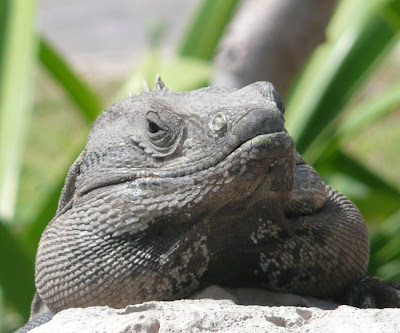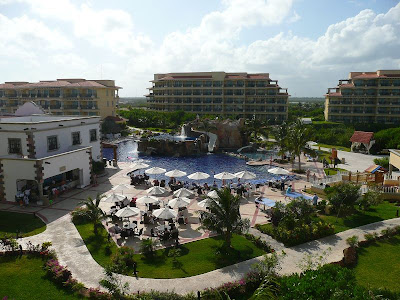
Enough navel gazing! Rather than sitting around on the boat, we’ve been industriously touring by bus as Doug recuperates – the marathon tour to Chichen Itza, the kinder, gentler tour to Tulum, the public bus to Playa del Carmen, and even, sort of by mistake, a ride around the strictly local side of Cancun. And we took a tour of the resort associated with our marina – a time-share sales pitch -WHEW!
Mexico -the Yucatan part anyhow- is coming into focus rather in the way that a black-and-white print appears through its developing bath in a darkroom. I’ve never minded clearing customs, or grocery shopping, or any of the other mechanics of cruising because you get to peek behind the curtain. The hospital, and now the buses, are serving the same purpose.
There really is a lot to like, especially about the people. Here in Quintana Roo, and further south too, they’re Mayans. I hadn’t quite registered that when Cortez arrived from Spain in the 1500s and started swinging his sword, the Mayan culture had already peaked and dwindled– the temple builders were gone for mysterious reasons of their own and their temples were being overtaken by jungle.
The Mayan people are still here and elsewhere in (Central) America, only without the memory of their ancestors’ exploits. Now, they’re dealing with a not-entirely unwelcome invasion of tourists.
Their land is a flat limestone plateau, no rivers, except underground, not much soil, full of sinkholes, tilting slightly towards the sea. Their jungle, what I’ve seen, looks more like scrub than rainforest. But the Yucatan has beautiful white sand beaches, clear turquoise water, sunshine and warmth.
Until about 40 years ago it didn’t have much else. Then the Mexican government waved its wand. Now the former 1000-soul fishing village of Cancun has half a million people and 27,000 hotel rooms on a 12-mile long off-lying strip of beach. The rest of the coast has been dubbed the Riviera Maya and every couple miles there’s another ostentatiously gated, fenced, all-inclusive resort on the beach. All told there are an additional 20,000 hotel rooms on the Riviera, plus golf courses, condos, villas, etc, etc. and more coming.
There’s some big percentage of Mexico’s foreign exchange that supposedly comes from this place. It’s also said that forty percent of the hotel jobs are reserved for the Mayan people. And I’ll bet the minimum wage is pretty minimal.
So, considering the tourists and the politics, I’m pleasantly surprised at how nice everybody is. You can walk, down the gauntlet of vendors at the temple sites, between little shops in places like Isla Mujeres, and even in the more upscale shopping street, Fifth Avenue, of Playa del Carmen and salespeople will try to interest you in their goods. Sometimes you’ll hear a little whisper “Cheaper than K-Mart!” or “Why you in so much hurry? Take your time!”
It’s done in such a friendly, good-humored, non-aggressive way. If you say no, thank you, they’ll go back to their conversations, their cell phones, their music, with a smile. You don’t get the feeling that some child will not be able to go to school if you don’t buy that mariachi hat. Or that you’ll get jumped in the alley. In fact, in Isla Mujeres no one even locks their dinghies on the beach – there have been no incidents for years.

I’m glad they seem to be keeping their balance, because there some pretty striking nominees for the Tourist Hall of Shame in the drunk, loud, and naked categories. What would possess a middle-aged man, waiting to see a bank manager (female), to wear a T-shirt advertising his genitalia:“I’m SHY. But my (not BRAIN!) is BIG.” Maybe he was dressed by someone who didn’t like him much.
Well, I didn’t intend to rewrite the cruising guide, or launch a screed on the politics of giving all your beach front to international hotel conglomerates so they can build luxury enclaves out of imported materials for disrespectful tourists, so I’ll move on.

Actually, I’d happily vacation here, in a place like Puerto Moreles, a small town with small hotels, pensiones, apartments, with beautiful beaches, a snorkeling reef a couple hundred feet out, bus connections to everywhere, nice people. Why, there’s even an English-language bookstore – all those Canadians need to read!

And I wouldn’t be alone- it seems that many gringos live in this area, at least seasonally. The Spanish-speaking tourists, and there are several, seem to come from (South)America, Bolivia, Argentina.
Almost every American chain store is here too, from Sam’s Club to Hooters to Ernst & Young. The parking lots are small, and the box stores smaller yet. I’ve hardly seen any SUVs, and the ones I have seen are all from the Federal District – Mexico City.

I’ve been seeing high school age school children, both boys and girls, carrying dolls. I probably terrorized the young man I attempted to interview on the subject, but learned it’s a school form of family-planning class – the doll has to stay with you all the time. It is hoped you’ll remember what that means exactly when you’re tempted to make one of your own. The thing is: these are small, dark people, and the dolls are like the tourists, big, pink, blue-eyed North American.















